
How to win the Pakistan Super League
Ahead of the eighth edition of the PSL, we look at some of the keys to success in the highly competitive league.
Qualification
As always, four of the teams will qualify for the knockout rounds, meaning you’d have to be a fairly awful side to miss out on the playoffs consistently, and also, reaching that stage shouldn’t be seen as an achievement. A prime example of this would be Karachi Kings:
Note - Multan have only featured in five of the seven PSL seasons

Their impressive playoff record is often talked about on commentary (joint 2nd best), qualifying for the knockout rounds in 6/7 seasons. Despite that, they also have the worst win percentage in PSL history. They’ve been consistently mediocre but have been rewarded by virtue of allowing two-thirds of the teams in the competition to participate in the knockout rounds.
Venues/Conditions
Four venues are set to be used – Karachi, Lahore, Multan, and Rawalpindi, all of which have been used frequently over the last few years, both domestically and during the PSL. All have generally been similar, offering friendly batting conditions and high-scoring matches:
Includes PSL, NT20 & T20 international matches since the start of 2020.

There isn’t much to split the venues, though Karachi does appear to have the best batting conditions. However, it’s worth noting that Karachi has benefitted from not hosting any games in the last two NT20 Cup seasons – comfortably the two lowest-scoring tournaments held in Pakistan over the last few years:
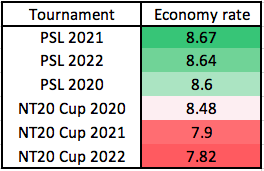
Meanwhile, Pindi has hosted 34 games during these two tournaments (52%), which could help explain why batting totals there are slightly lower, despite being thought of as one of the better batting venues in Pakistan.
As well as being a high-scoring venue, Karachi also looks to be the most toss-dependent, with a strong chasing bias. A strong chasing bias is something that’s been a theme in the majority of the PSL seasons that have taken place; however, that wasn’t the case last season:
CW = chasing wins, CWP = chasing win percentage
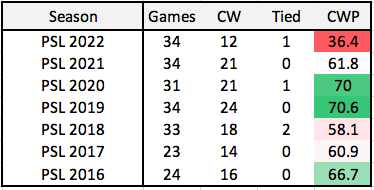
Last season was a real anomaly for a league that’s typically been one of the most favorable for chasing sides. I’m not sure there’s an obvious reason for this, and for now, we’ll have to assume it is just an anomaly. Sometimes this can happen as a result of the weaker sides in the league chasing often, which was sort of the case last season, with Karachi & Quetta chasing on 12 occasions, winning only three of those. Even when removing those games, it leaves only nine wins from 21 games for chasing sides, which is still well below the average chasing win percentage from previous seasons.
Another possible reason could be that pitches were more conducive to spin last season, especially during the second half of the tournament, when games were being played in Lahore. This possibly surprised franchises and disrupted the template for chasing in PSL matches:

This, combined with the fact that teams were more RH-heavy than they’ve been previously, could’ve been one of the reasons why chasing was more difficult than it has been in the past. Overall though, I’d expect it to rebound this season, even if conditions are similar, as last season was such a significant anomaly.
Based on their recruitment, it does look like teams are anticipating similar conditions to what we saw last year, or they’re just basing it on what happened last season, with many teams opting to recruit at least one overseas spinner, most of which are mystery/wrist spin options. This could be considered a risk, based on the fact that bowling spin has been notoriously tricky in the PSL compared to most other leagues:
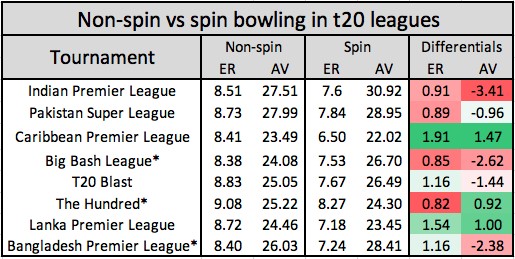
And the above table includes last season, which was the season where spinners had the most success and quite comfortably:

Based on the domestic player pool, signing more quality spin options largely makes sense, with many of the batters struggling to accelerate against spin. Perhaps high-quality spin has been underutilized in the past PSL seasons. Multan sort of tried to exploit this a couple of years back by picking three wrist spinners in their squad but didn’t fully commit to it. In any case, it’ll be interesting to see how things play out this season, with perhaps more wrist spin options signed than in previous seasons.
As for the PSL itself, the scoring rate has been remarkably similar in recent seasons, with a batting scoring rate of 8.16, 8.17 & 8.17 RPO in the last three seasons. It could imply there’s a ceiling for how high we can expect run rates to climb, though the scoring rate in the first half of last season suggests otherwise. It’ll be interesting to see how the PSL develops in the coming years – a league renowned for its high-scoring matches, especially recently, but the focus on recruiting overseas batters could be part of that.
Pakistan is a country well known for its production of left-arm pacers, whether that’s Wasim Akram, the youthful version of Mohammad Amir, Wahab Riaz, or, more recently – Shaheen Shah Afridi. Pakistan cricket and left-arm pacers basically go hand in hand, and that’s highlighted in the PSL:
Data for the last three seasons of each league. * = only two seasons of data.

The PSL is fairly comfortably ahead of the rest when it comes to % of deliveries bowled by LA pace. It doesn’t just happen for the sake of it either; they’re generally quite successful:

Left-arm pacers are more economical, relative to the tournament average than in any other T20 league, although they don’t necessarily have the same wicket-taking threat compared to some other leagues, most notably the BPL.
Other than the amount of LA pace bowled, there isn’t much that stands out about different bowling types and how they fare in the PSL. Wrist spin is generally a good option, while off-spin has perhaps been slightly under-utilized as a matchup option – no league bowls a lower % of deliveries through off-spin. However, given the ease of batting conditions, that’s possibly understandable. Mystery spin has fared poorly in the PSL, but the sample size isn’t big enough to judge, as it basically only includes half a season from Mujeeb.
All in all, LA pace and wrist spin look to be the most optimal routes to consistent success in the PSL.
Keys to Success
Most leagues usually have a few standout characteristics, more obvious correlators with success, that separate them from other leagues. I’m not sure that’s necessarily the case with the PSL:
Doesn’t include the most recent BBL season

You could argue it’s the same with the IPL. Both leagues have good pitches and are very competitive, paving the way for many different strategies to succeed. There are still a few things that are worth mentioning, though:
- Batting average: Not for one second am I saying that a team of ‘anchors’ should be picked; you still need to be able to score runs quickly. However, there’s possibly more of an emphasis on individuals that can make bigger scores in the PSL due to the conditions generally being very good for batting. Quick cameos aren’t necessarily as beneficial; you need extended periods of dominance.
- Pace bowling: This tends to be important in most leagues but perhaps even more so in the PSL, where a high % of deliveries are bowled by pacers. If we look at previous PSL winners, it clearly highlights the importance of pace bowling in this league:

All of the last five PSL winners have had a top two pace attack in terms of economy rate, while four have had a top two pace attack, in terms of average, with Karachi being the only exception, which perhaps shouldn’t be too surprising with Amir as the lead pacer in that team. It’s also worth noting that the title-winning Karachi side was arguably the weakest/most fortunate to win the PSL in recent seasons:
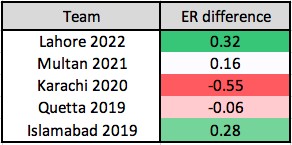
They clearly had the worst ER difference, which is a good indicator of team strength, which could explain why they were the only side that didn’t have a top-two pace attack for both economy rates & average.
- Wrist spin: As explained in those tables earlier, wrist spin has generally been effective in the PSL and has possibly been underused. Only the BPL, T20 Blast, and CPL have had a lower % of deliveries bowled through wrist spin, and given the success of some of the incumbent wrist spinners, especially the overseas ones they have had, this is a bit surprising.
- Overseas batters: Overseas batters play a more prominent role in the PSL than in most other leagues – facing a high percentage of deliveries and generally outperforming the domestic players quite comfortably. As such, the importance of having quality overseas batters can’t be understated:
Data for top-7 batters in the last three seasons

There’s a far greater correlation between the strike rates of overseas batters and win percentage than for anything else. In particular, the strike rate of local batters has tended to be relatively insignificant, and it’ll be interesting to see if this holds true in the coming seasons.
Caution with 2022 NT20 Performers
While many of the local players picked have performed well domestically, there should be an element of caution, particularly when looking at performances from the most recent season, in the NT20 Cup specifically. This is because of the obvious drop-off in quality during the 2022 campaign, where many of the national players were unavailable, significantly weakening the standard of the competition:

Pakistan players = 37 players that have represented them in T20Is since the start of 2020. Top 20 = 20 players with the most T20I appearances since the start of 2020.
There was a big fall in the % of appearances made by Pakistan players in the NT20 cup this season. It was even more extreme when looking at the representation of the top T20 players in Pakistan. Due to the ongoing international series and then the T20 WC, most of the best players weren’t involved.
Things look worse when you look at the balls faced/bowled in the NT20 Cup because most of the Pakistan players would’ve had crucial roles with bat/ball or both in the domestic teams that they featured in:


With this in mind and the fact there are obviously no overseas players in the NT20 Cup, caution should be advised with expectations for many of the newer domestic players for the upcoming PSL season. I’d say this is particularly appropriate for the bowlers, considering the relevance of overseas batters in the PSL, both in terms of their success, compared to domestic players and the number of balls they tend to face:
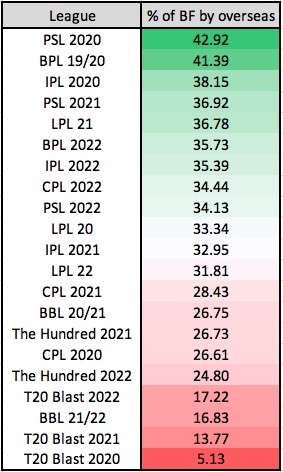
A couple of the PSL seasons, in particular, have been amongst the highest for % of deliveries faced by overseas players, and most of those players have been very successful:
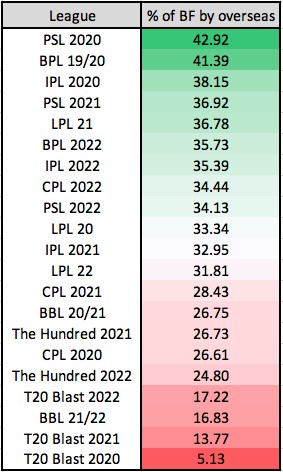
The overseas batters generally perform much better, relative to the success of the domestic batters, than in most other leagues. This is perhaps down to the quality of recruitment from PSL teams, as well as easier batting conditions in the PSL than most other leagues and the role that the overseas players tend to occupy, often batting at the top or lower down as ‘finishers.’ Nevertheless, you’d think this would make it very tricky for domestic bowlers, especially from the most recent season. The step up in quality will be huge – going from closer to a 2nd XI competition to bowling 80% of deliveries against Pakistan internationals/overseas players.
It should be slightly easier for the batters, as the PSL has tended to focus less on overseas bowler recruitment than most other leagues:
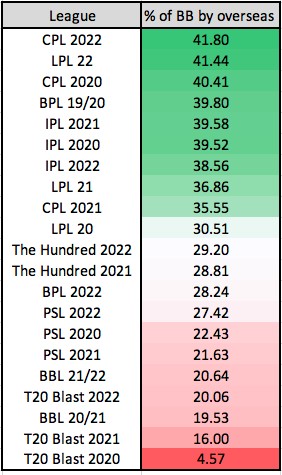
Of the leagues that allow four overseas players per XI (IPL, PSL, CPL, BPL & LPL), the PSL comfortably has the lowest % of deliveries bowled by overseas players. However, it is interesting to note the 2022 figures for balls faced/bowled, with a much closer difference than in previous seasons, highlighting a possible switch in approach from PSL franchises.
This isn’t necessarily surprising considering the strength of the domestic pace bowlers in the PSL, but it probably makes it a bit easier for domestic batters to make the step up rather than their bowling counterparts.


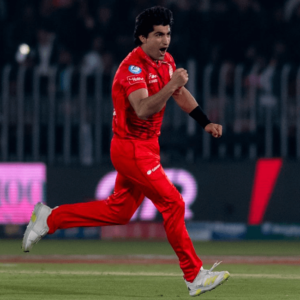


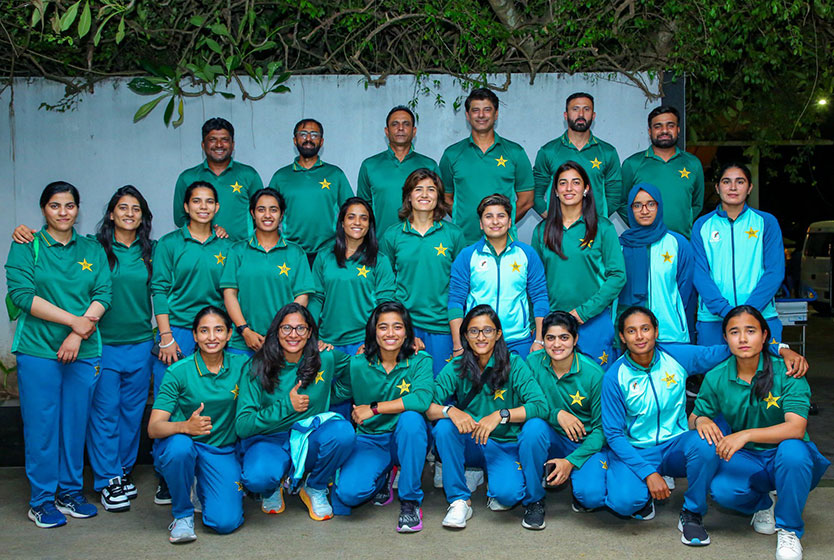
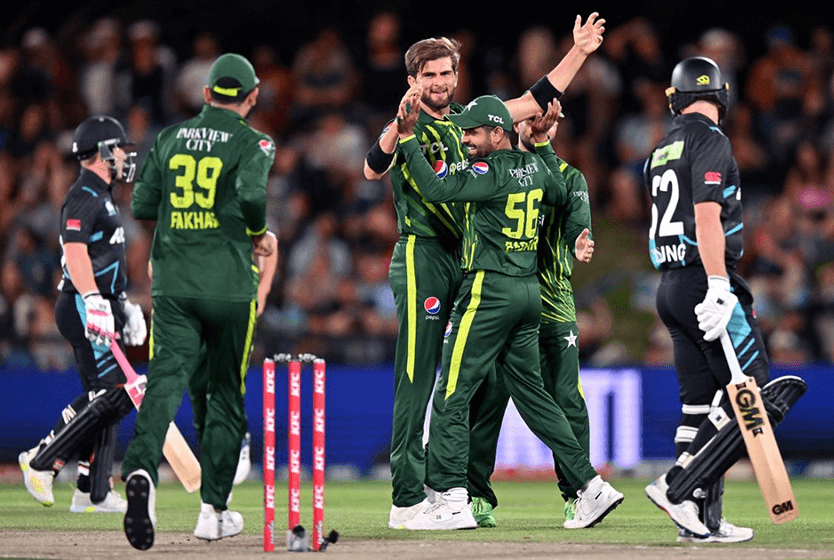
Leave a Reply